Rethinking Project Management in Delivering Sustainable Development
VerifiedAdded on 2022/09/01
|10
|2133
|17
Essay
AI Summary
This essay delves into rethinking project management, focusing on the delivery of sustainable development through infrastructure projects. It analyzes a chosen project related to the Infrastructure Sustainability Council of Australia (ISCA) and its role in promoting sustainable outcomes. The essay examines the IS rating scheme (V2.0) used to evaluate the sustainability of infrastructure projects across various sectors, including governance, economic, environmental, and social aspects. The analysis explores the challenges and opportunities within the infrastructure sector, highlighting the need for sustainable practices to address issues such as climate change and resource scarcity. The essay further discusses the ISCA's approach to incentivizing sustainable infrastructure projects and its impact on achieving Sustainable Development Goals (SDGs). It also considers the processes involved in the IS rating scheme, its alignment with sustainable development, and the benefits of fostering innovation and continuous improvement in the infrastructure industry. The essay concludes by reflecting on the importance of sustainable infrastructure for improving quality of life, protecting the environment, and the role of smart investments in achieving these goals.
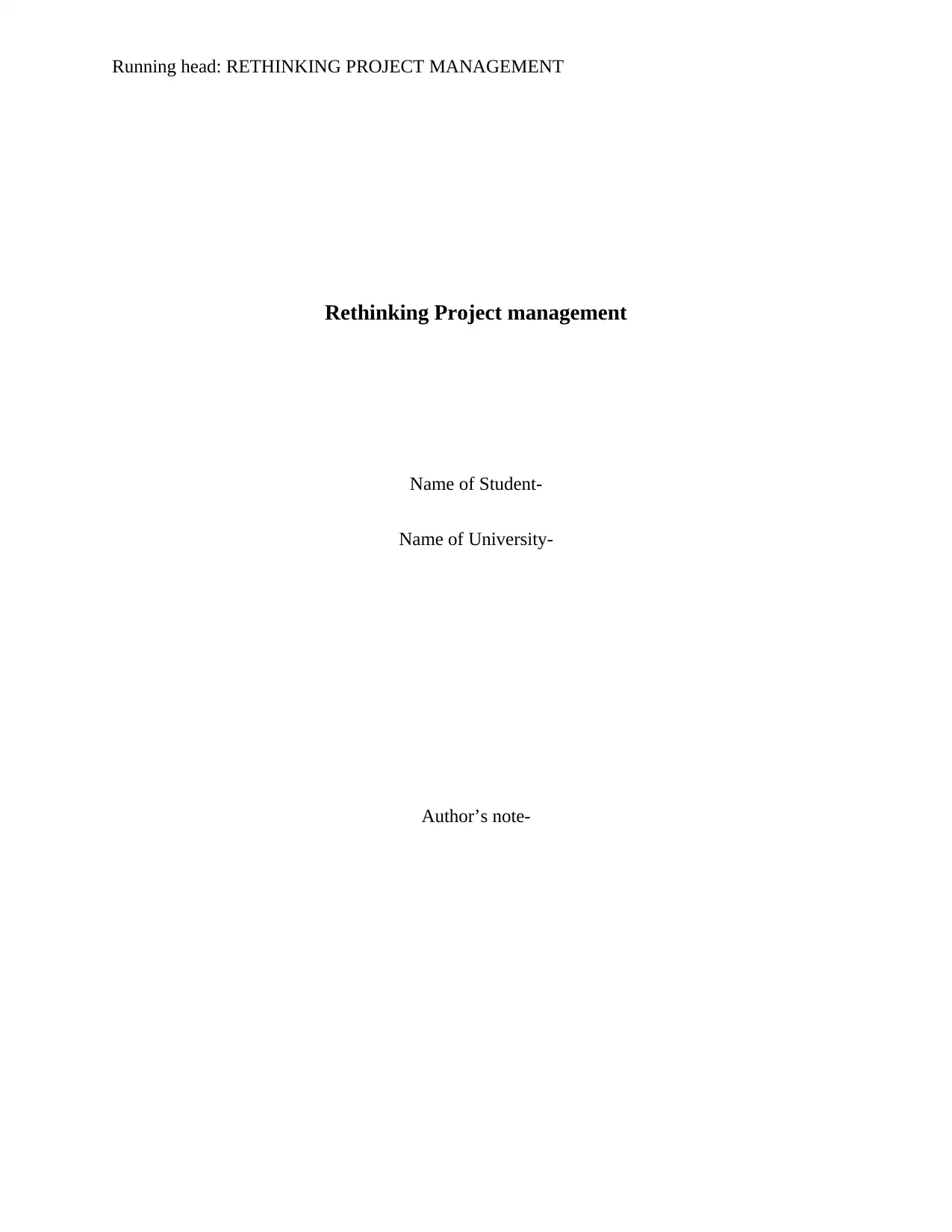
Running head: RETHINKING PROJECT MANAGEMENT
Rethinking Project management
Name of Student-
Name of University-
Author’s note-
Rethinking Project management
Name of Student-
Name of University-
Author’s note-
Secure Best Marks with AI Grader
Need help grading? Try our AI Grader for instant feedback on your assignments.
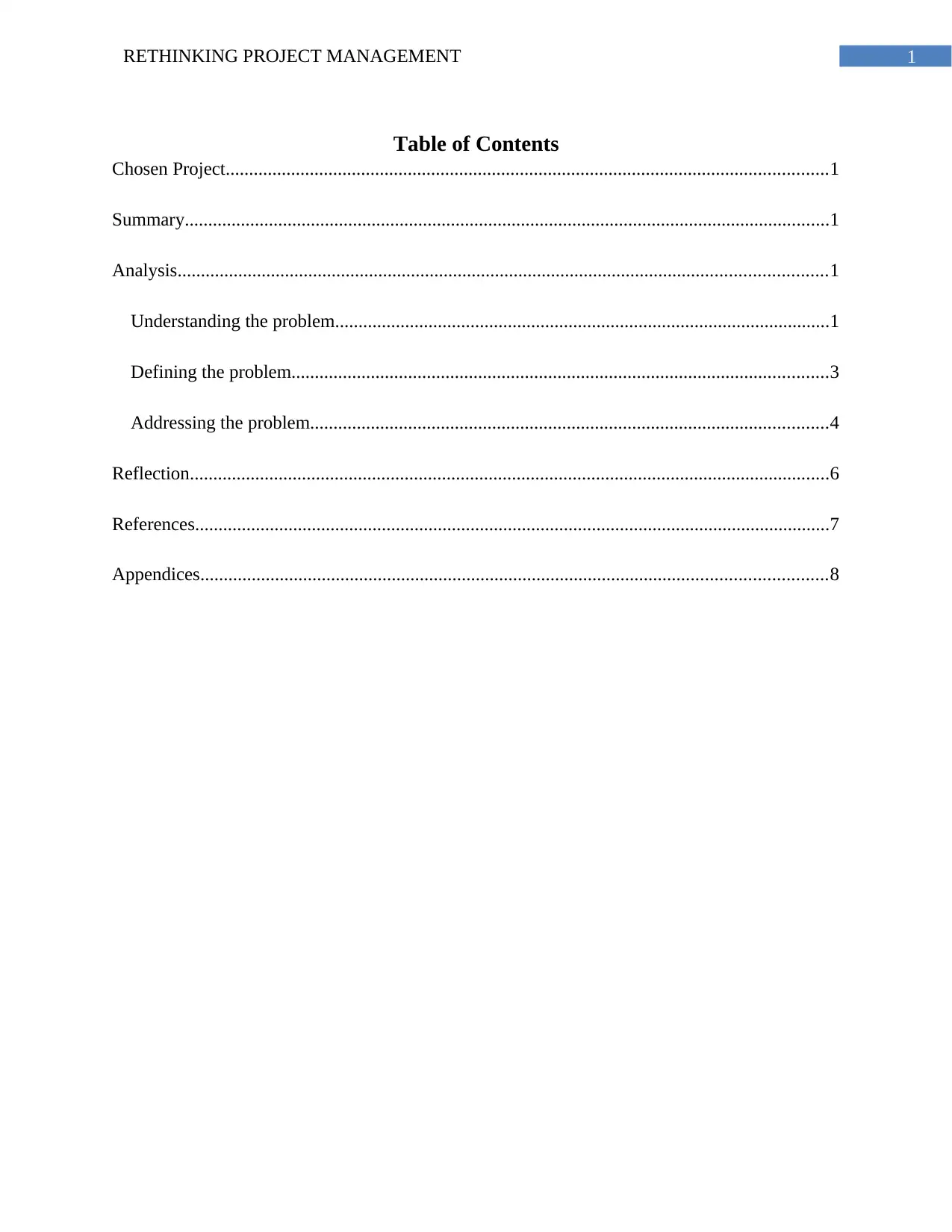
1RETHINKING PROJECT MANAGEMENT
Table of Contents
Chosen Project.................................................................................................................................1
Summary..........................................................................................................................................1
Analysis...........................................................................................................................................1
Understanding the problem..........................................................................................................1
Defining the problem...................................................................................................................3
Addressing the problem...............................................................................................................4
Reflection.........................................................................................................................................6
References........................................................................................................................................7
Appendices......................................................................................................................................8
Table of Contents
Chosen Project.................................................................................................................................1
Summary..........................................................................................................................................1
Analysis...........................................................................................................................................1
Understanding the problem..........................................................................................................1
Defining the problem...................................................................................................................3
Addressing the problem...............................................................................................................4
Reflection.........................................................................................................................................6
References........................................................................................................................................7
Appendices......................................................................................................................................8
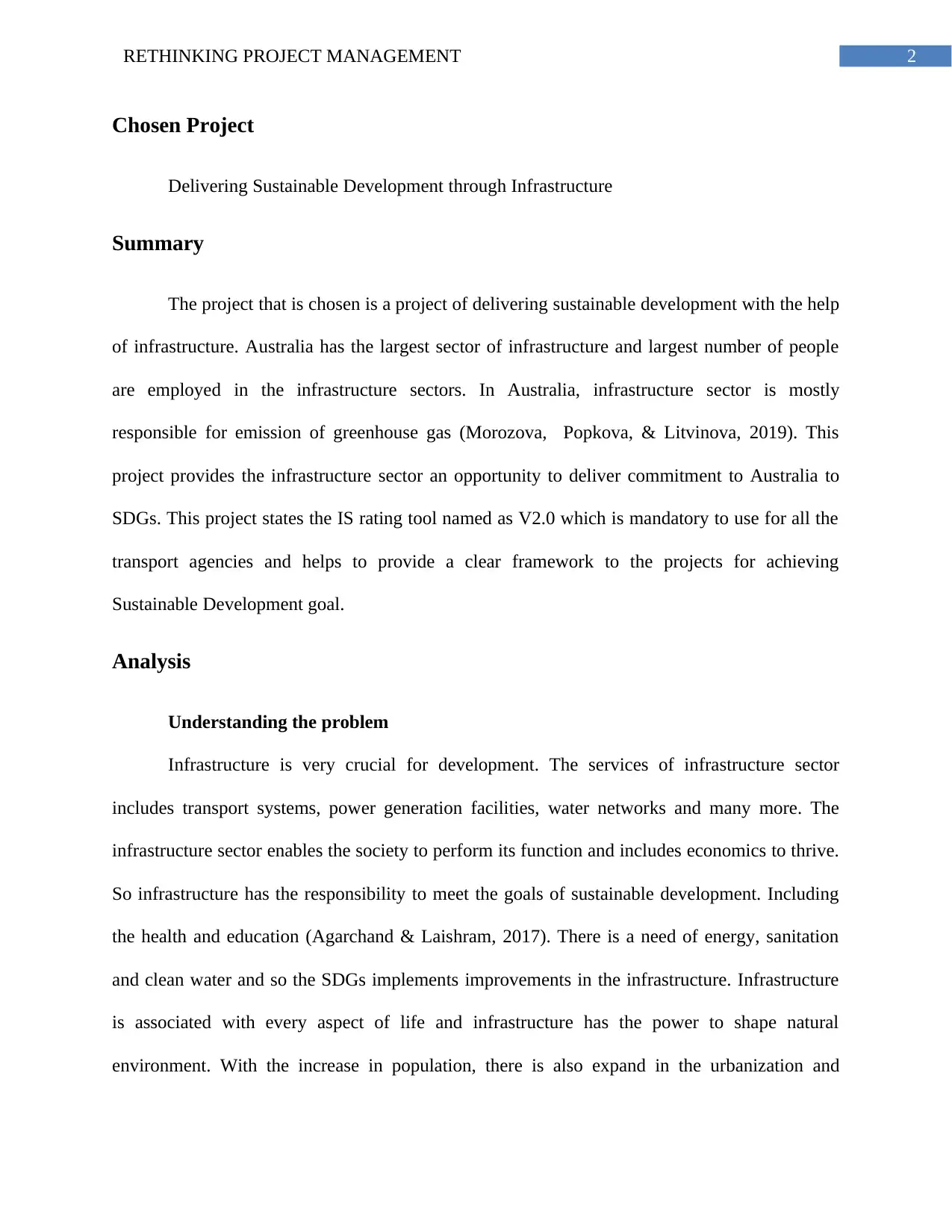
2RETHINKING PROJECT MANAGEMENT
Chosen Project
Delivering Sustainable Development through Infrastructure
Summary
The project that is chosen is a project of delivering sustainable development with the help
of infrastructure. Australia has the largest sector of infrastructure and largest number of people
are employed in the infrastructure sectors. In Australia, infrastructure sector is mostly
responsible for emission of greenhouse gas (Morozova, Popkova, & Litvinova, 2019). This
project provides the infrastructure sector an opportunity to deliver commitment to Australia to
SDGs. This project states the IS rating tool named as V2.0 which is mandatory to use for all the
transport agencies and helps to provide a clear framework to the projects for achieving
Sustainable Development goal.
Analysis
Understanding the problem
Infrastructure is very crucial for development. The services of infrastructure sector
includes transport systems, power generation facilities, water networks and many more. The
infrastructure sector enables the society to perform its function and includes economics to thrive.
So infrastructure has the responsibility to meet the goals of sustainable development. Including
the health and education (Agarchand & Laishram, 2017). There is a need of energy, sanitation
and clean water and so the SDGs implements improvements in the infrastructure. Infrastructure
is associated with every aspect of life and infrastructure has the power to shape natural
environment. With the increase in population, there is also expand in the urbanization and
Chosen Project
Delivering Sustainable Development through Infrastructure
Summary
The project that is chosen is a project of delivering sustainable development with the help
of infrastructure. Australia has the largest sector of infrastructure and largest number of people
are employed in the infrastructure sectors. In Australia, infrastructure sector is mostly
responsible for emission of greenhouse gas (Morozova, Popkova, & Litvinova, 2019). This
project provides the infrastructure sector an opportunity to deliver commitment to Australia to
SDGs. This project states the IS rating tool named as V2.0 which is mandatory to use for all the
transport agencies and helps to provide a clear framework to the projects for achieving
Sustainable Development goal.
Analysis
Understanding the problem
Infrastructure is very crucial for development. The services of infrastructure sector
includes transport systems, power generation facilities, water networks and many more. The
infrastructure sector enables the society to perform its function and includes economics to thrive.
So infrastructure has the responsibility to meet the goals of sustainable development. Including
the health and education (Agarchand & Laishram, 2017). There is a need of energy, sanitation
and clean water and so the SDGs implements improvements in the infrastructure. Infrastructure
is associated with every aspect of life and infrastructure has the power to shape natural
environment. With the increase in population, there is also expand in the urbanization and
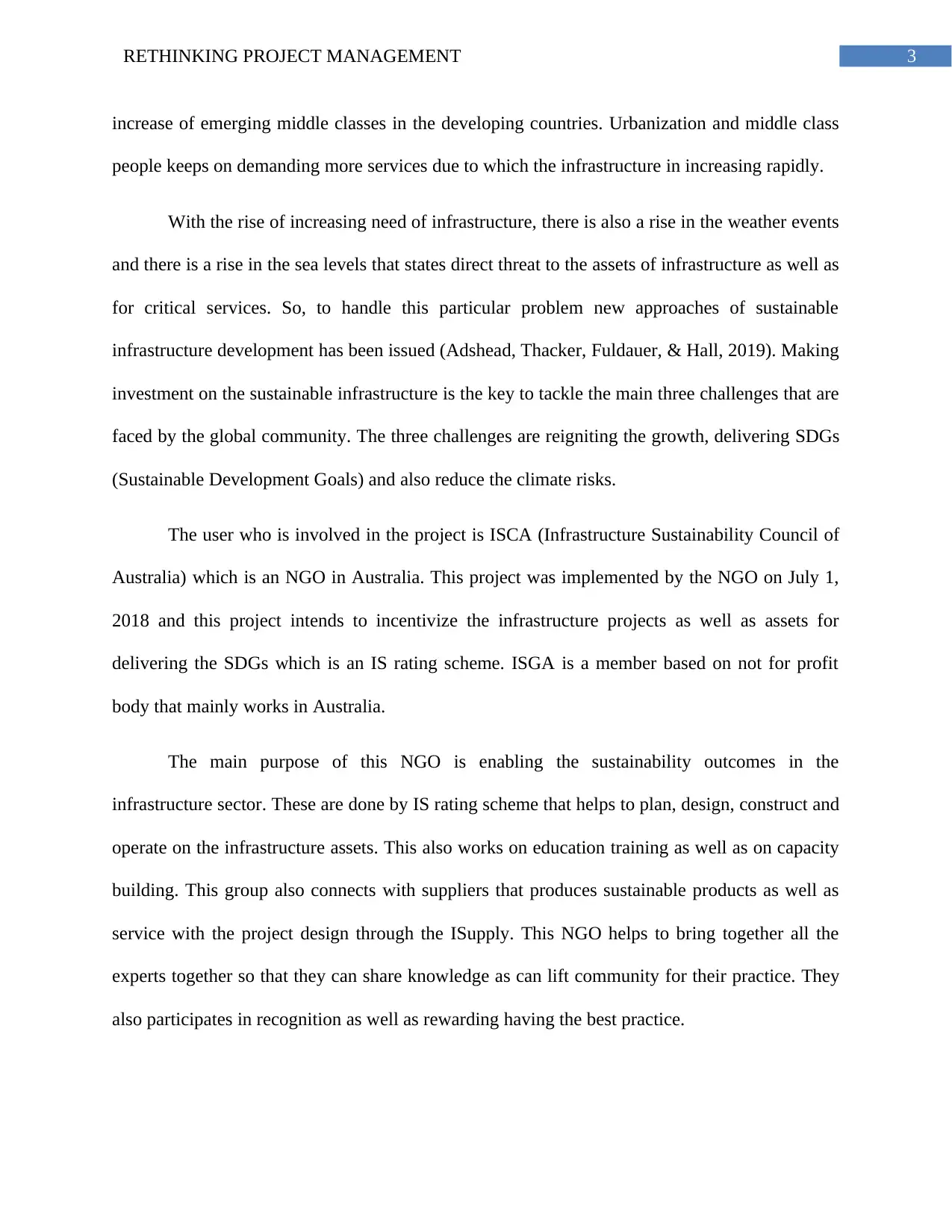
3RETHINKING PROJECT MANAGEMENT
increase of emerging middle classes in the developing countries. Urbanization and middle class
people keeps on demanding more services due to which the infrastructure in increasing rapidly.
With the rise of increasing need of infrastructure, there is also a rise in the weather events
and there is a rise in the sea levels that states direct threat to the assets of infrastructure as well as
for critical services. So, to handle this particular problem new approaches of sustainable
infrastructure development has been issued (Adshead, Thacker, Fuldauer, & Hall, 2019). Making
investment on the sustainable infrastructure is the key to tackle the main three challenges that are
faced by the global community. The three challenges are reigniting the growth, delivering SDGs
(Sustainable Development Goals) and also reduce the climate risks.
The user who is involved in the project is ISCA (Infrastructure Sustainability Council of
Australia) which is an NGO in Australia. This project was implemented by the NGO on July 1,
2018 and this project intends to incentivize the infrastructure projects as well as assets for
delivering the SDGs which is an IS rating scheme. ISGA is a member based on not for profit
body that mainly works in Australia.
The main purpose of this NGO is enabling the sustainability outcomes in the
infrastructure sector. These are done by IS rating scheme that helps to plan, design, construct and
operate on the infrastructure assets. This also works on education training as well as on capacity
building. This group also connects with suppliers that produces sustainable products as well as
service with the project design through the ISupply. This NGO helps to bring together all the
experts together so that they can share knowledge as can lift community for their practice. They
also participates in recognition as well as rewarding having the best practice.
increase of emerging middle classes in the developing countries. Urbanization and middle class
people keeps on demanding more services due to which the infrastructure in increasing rapidly.
With the rise of increasing need of infrastructure, there is also a rise in the weather events
and there is a rise in the sea levels that states direct threat to the assets of infrastructure as well as
for critical services. So, to handle this particular problem new approaches of sustainable
infrastructure development has been issued (Adshead, Thacker, Fuldauer, & Hall, 2019). Making
investment on the sustainable infrastructure is the key to tackle the main three challenges that are
faced by the global community. The three challenges are reigniting the growth, delivering SDGs
(Sustainable Development Goals) and also reduce the climate risks.
The user who is involved in the project is ISCA (Infrastructure Sustainability Council of
Australia) which is an NGO in Australia. This project was implemented by the NGO on July 1,
2018 and this project intends to incentivize the infrastructure projects as well as assets for
delivering the SDGs which is an IS rating scheme. ISGA is a member based on not for profit
body that mainly works in Australia.
The main purpose of this NGO is enabling the sustainability outcomes in the
infrastructure sector. These are done by IS rating scheme that helps to plan, design, construct and
operate on the infrastructure assets. This also works on education training as well as on capacity
building. This group also connects with suppliers that produces sustainable products as well as
service with the project design through the ISupply. This NGO helps to bring together all the
experts together so that they can share knowledge as can lift community for their practice. They
also participates in recognition as well as rewarding having the best practice.
Secure Best Marks with AI Grader
Need help grading? Try our AI Grader for instant feedback on your assignments.
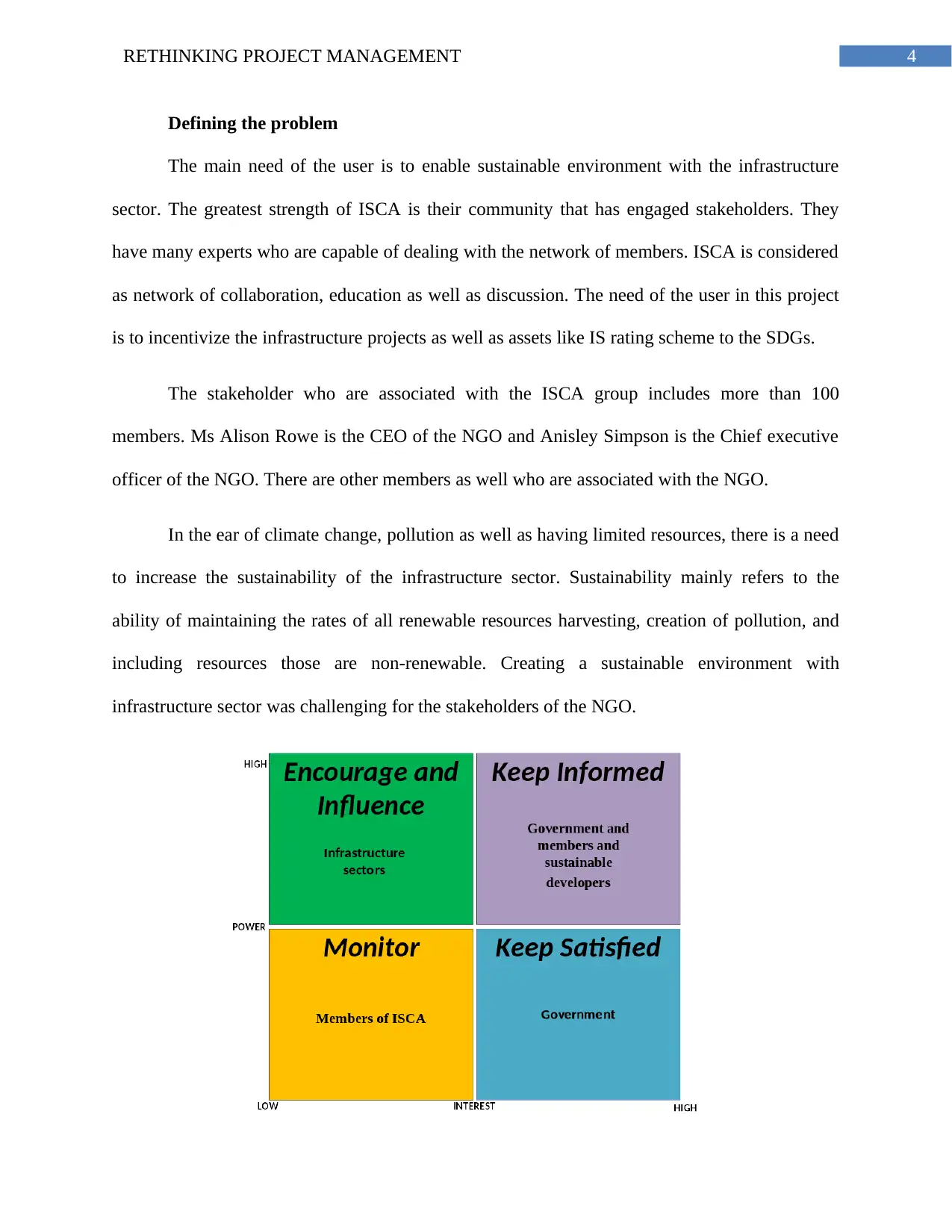
4RETHINKING PROJECT MANAGEMENT
Defining the problem
The main need of the user is to enable sustainable environment with the infrastructure
sector. The greatest strength of ISCA is their community that has engaged stakeholders. They
have many experts who are capable of dealing with the network of members. ISCA is considered
as network of collaboration, education as well as discussion. The need of the user in this project
is to incentivize the infrastructure projects as well as assets like IS rating scheme to the SDGs.
The stakeholder who are associated with the ISCA group includes more than 100
members. Ms Alison Rowe is the CEO of the NGO and Anisley Simpson is the Chief executive
officer of the NGO. There are other members as well who are associated with the NGO.
In the ear of climate change, pollution as well as having limited resources, there is a need
to increase the sustainability of the infrastructure sector. Sustainability mainly refers to the
ability of maintaining the rates of all renewable resources harvesting, creation of pollution, and
including resources those are non-renewable. Creating a sustainable environment with
infrastructure sector was challenging for the stakeholders of the NGO.
Defining the problem
The main need of the user is to enable sustainable environment with the infrastructure
sector. The greatest strength of ISCA is their community that has engaged stakeholders. They
have many experts who are capable of dealing with the network of members. ISCA is considered
as network of collaboration, education as well as discussion. The need of the user in this project
is to incentivize the infrastructure projects as well as assets like IS rating scheme to the SDGs.
The stakeholder who are associated with the ISCA group includes more than 100
members. Ms Alison Rowe is the CEO of the NGO and Anisley Simpson is the Chief executive
officer of the NGO. There are other members as well who are associated with the NGO.
In the ear of climate change, pollution as well as having limited resources, there is a need
to increase the sustainability of the infrastructure sector. Sustainability mainly refers to the
ability of maintaining the rates of all renewable resources harvesting, creation of pollution, and
including resources those are non-renewable. Creating a sustainable environment with
infrastructure sector was challenging for the stakeholders of the NGO.
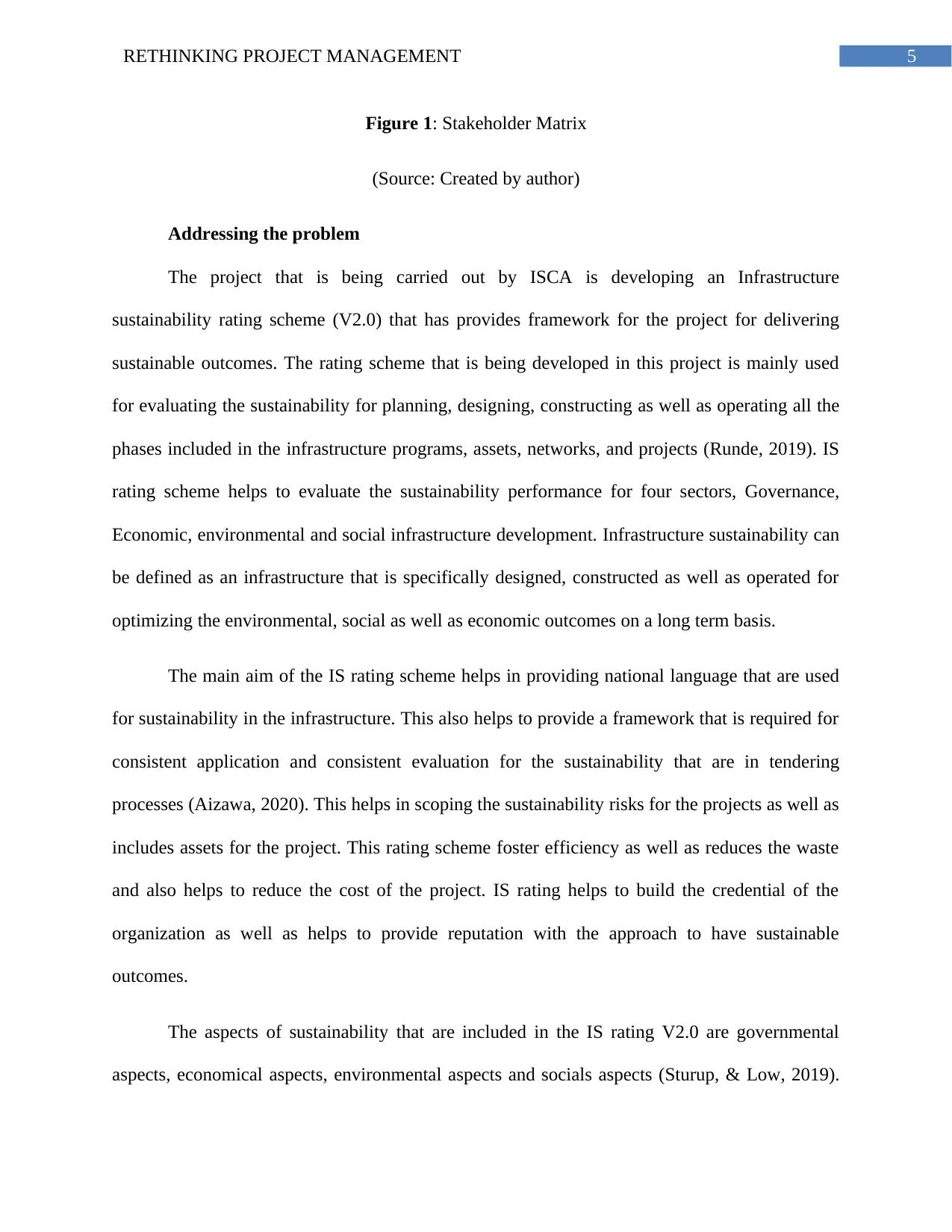
5RETHINKING PROJECT MANAGEMENT
Figure 1: Stakeholder Matrix
(Source: Created by author)
Addressing the problem
The project that is being carried out by ISCA is developing an Infrastructure
sustainability rating scheme (V2.0) that has provides framework for the project for delivering
sustainable outcomes. The rating scheme that is being developed in this project is mainly used
for evaluating the sustainability for planning, designing, constructing as well as operating all the
phases included in the infrastructure programs, assets, networks, and projects (Runde, 2019). IS
rating scheme helps to evaluate the sustainability performance for four sectors, Governance,
Economic, environmental and social infrastructure development. Infrastructure sustainability can
be defined as an infrastructure that is specifically designed, constructed as well as operated for
optimizing the environmental, social as well as economic outcomes on a long term basis.
The main aim of the IS rating scheme helps in providing national language that are used
for sustainability in the infrastructure. This also helps to provide a framework that is required for
consistent application and consistent evaluation for the sustainability that are in tendering
processes (Aizawa, 2020). This helps in scoping the sustainability risks for the projects as well as
includes assets for the project. This rating scheme foster efficiency as well as reduces the waste
and also helps to reduce the cost of the project. IS rating helps to build the credential of the
organization as well as helps to provide reputation with the approach to have sustainable
outcomes.
The aspects of sustainability that are included in the IS rating V2.0 are governmental
aspects, economical aspects, environmental aspects and socials aspects (Sturup, & Low, 2019).
Figure 1: Stakeholder Matrix
(Source: Created by author)
Addressing the problem
The project that is being carried out by ISCA is developing an Infrastructure
sustainability rating scheme (V2.0) that has provides framework for the project for delivering
sustainable outcomes. The rating scheme that is being developed in this project is mainly used
for evaluating the sustainability for planning, designing, constructing as well as operating all the
phases included in the infrastructure programs, assets, networks, and projects (Runde, 2019). IS
rating scheme helps to evaluate the sustainability performance for four sectors, Governance,
Economic, environmental and social infrastructure development. Infrastructure sustainability can
be defined as an infrastructure that is specifically designed, constructed as well as operated for
optimizing the environmental, social as well as economic outcomes on a long term basis.
The main aim of the IS rating scheme helps in providing national language that are used
for sustainability in the infrastructure. This also helps to provide a framework that is required for
consistent application and consistent evaluation for the sustainability that are in tendering
processes (Aizawa, 2020). This helps in scoping the sustainability risks for the projects as well as
includes assets for the project. This rating scheme foster efficiency as well as reduces the waste
and also helps to reduce the cost of the project. IS rating helps to build the credential of the
organization as well as helps to provide reputation with the approach to have sustainable
outcomes.
The aspects of sustainability that are included in the IS rating V2.0 are governmental
aspects, economical aspects, environmental aspects and socials aspects (Sturup, & Low, 2019).
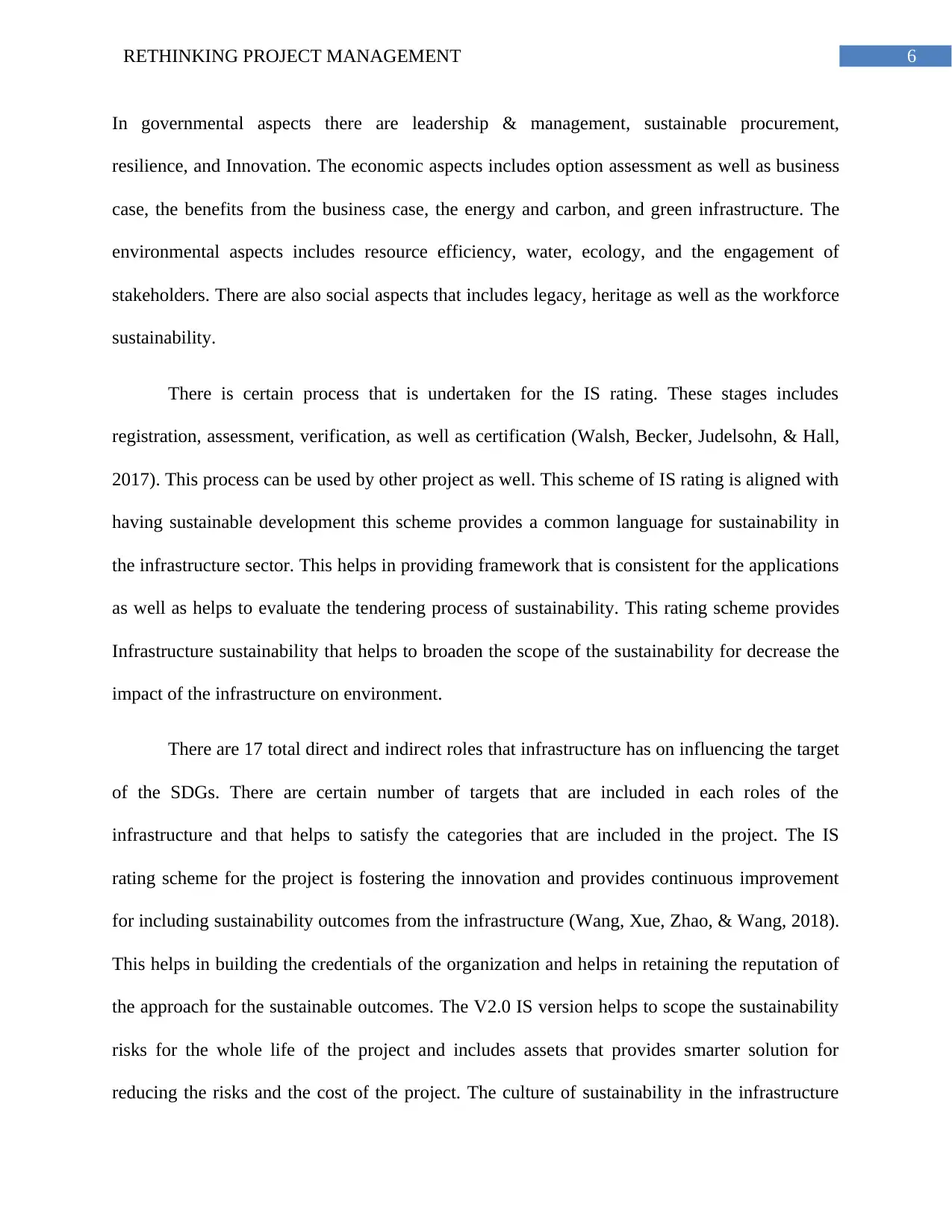
6RETHINKING PROJECT MANAGEMENT
In governmental aspects there are leadership & management, sustainable procurement,
resilience, and Innovation. The economic aspects includes option assessment as well as business
case, the benefits from the business case, the energy and carbon, and green infrastructure. The
environmental aspects includes resource efficiency, water, ecology, and the engagement of
stakeholders. There are also social aspects that includes legacy, heritage as well as the workforce
sustainability.
There is certain process that is undertaken for the IS rating. These stages includes
registration, assessment, verification, as well as certification (Walsh, Becker, Judelsohn, & Hall,
2017). This process can be used by other project as well. This scheme of IS rating is aligned with
having sustainable development this scheme provides a common language for sustainability in
the infrastructure sector. This helps in providing framework that is consistent for the applications
as well as helps to evaluate the tendering process of sustainability. This rating scheme provides
Infrastructure sustainability that helps to broaden the scope of the sustainability for decrease the
impact of the infrastructure on environment.
There are 17 total direct and indirect roles that infrastructure has on influencing the target
of the SDGs. There are certain number of targets that are included in each roles of the
infrastructure and that helps to satisfy the categories that are included in the project. The IS
rating scheme for the project is fostering the innovation and provides continuous improvement
for including sustainability outcomes from the infrastructure (Wang, Xue, Zhao, & Wang, 2018).
This helps in building the credentials of the organization and helps in retaining the reputation of
the approach for the sustainable outcomes. The V2.0 IS version helps to scope the sustainability
risks for the whole life of the project and includes assets that provides smarter solution for
reducing the risks and the cost of the project. The culture of sustainability in the infrastructure
In governmental aspects there are leadership & management, sustainable procurement,
resilience, and Innovation. The economic aspects includes option assessment as well as business
case, the benefits from the business case, the energy and carbon, and green infrastructure. The
environmental aspects includes resource efficiency, water, ecology, and the engagement of
stakeholders. There are also social aspects that includes legacy, heritage as well as the workforce
sustainability.
There is certain process that is undertaken for the IS rating. These stages includes
registration, assessment, verification, as well as certification (Walsh, Becker, Judelsohn, & Hall,
2017). This process can be used by other project as well. This scheme of IS rating is aligned with
having sustainable development this scheme provides a common language for sustainability in
the infrastructure sector. This helps in providing framework that is consistent for the applications
as well as helps to evaluate the tendering process of sustainability. This rating scheme provides
Infrastructure sustainability that helps to broaden the scope of the sustainability for decrease the
impact of the infrastructure on environment.
There are 17 total direct and indirect roles that infrastructure has on influencing the target
of the SDGs. There are certain number of targets that are included in each roles of the
infrastructure and that helps to satisfy the categories that are included in the project. The IS
rating scheme for the project is fostering the innovation and provides continuous improvement
for including sustainability outcomes from the infrastructure (Wang, Xue, Zhao, & Wang, 2018).
This helps in building the credentials of the organization and helps in retaining the reputation of
the approach for the sustainable outcomes. The V2.0 IS version helps to scope the sustainability
risks for the whole life of the project and includes assets that provides smarter solution for
reducing the risks and the cost of the project. The culture of sustainability in the infrastructure
Paraphrase This Document
Need a fresh take? Get an instant paraphrase of this document with our AI Paraphraser
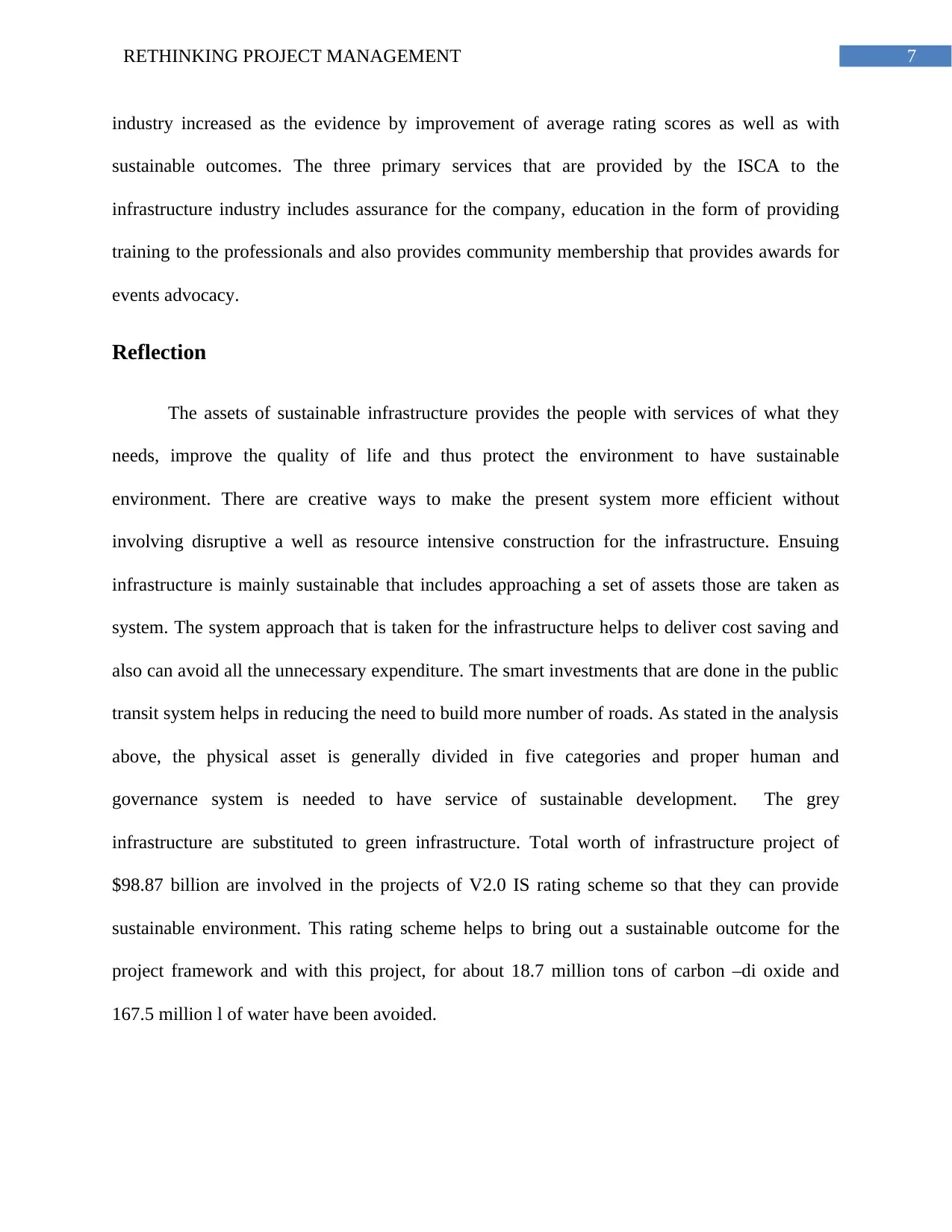
7RETHINKING PROJECT MANAGEMENT
industry increased as the evidence by improvement of average rating scores as well as with
sustainable outcomes. The three primary services that are provided by the ISCA to the
infrastructure industry includes assurance for the company, education in the form of providing
training to the professionals and also provides community membership that provides awards for
events advocacy.
Reflection
The assets of sustainable infrastructure provides the people with services of what they
needs, improve the quality of life and thus protect the environment to have sustainable
environment. There are creative ways to make the present system more efficient without
involving disruptive a well as resource intensive construction for the infrastructure. Ensuing
infrastructure is mainly sustainable that includes approaching a set of assets those are taken as
system. The system approach that is taken for the infrastructure helps to deliver cost saving and
also can avoid all the unnecessary expenditure. The smart investments that are done in the public
transit system helps in reducing the need to build more number of roads. As stated in the analysis
above, the physical asset is generally divided in five categories and proper human and
governance system is needed to have service of sustainable development. The grey
infrastructure are substituted to green infrastructure. Total worth of infrastructure project of
$98.87 billion are involved in the projects of V2.0 IS rating scheme so that they can provide
sustainable environment. This rating scheme helps to bring out a sustainable outcome for the
project framework and with this project, for about 18.7 million tons of carbon –di oxide and
167.5 million l of water have been avoided.
industry increased as the evidence by improvement of average rating scores as well as with
sustainable outcomes. The three primary services that are provided by the ISCA to the
infrastructure industry includes assurance for the company, education in the form of providing
training to the professionals and also provides community membership that provides awards for
events advocacy.
Reflection
The assets of sustainable infrastructure provides the people with services of what they
needs, improve the quality of life and thus protect the environment to have sustainable
environment. There are creative ways to make the present system more efficient without
involving disruptive a well as resource intensive construction for the infrastructure. Ensuing
infrastructure is mainly sustainable that includes approaching a set of assets those are taken as
system. The system approach that is taken for the infrastructure helps to deliver cost saving and
also can avoid all the unnecessary expenditure. The smart investments that are done in the public
transit system helps in reducing the need to build more number of roads. As stated in the analysis
above, the physical asset is generally divided in five categories and proper human and
governance system is needed to have service of sustainable development. The grey
infrastructure are substituted to green infrastructure. Total worth of infrastructure project of
$98.87 billion are involved in the projects of V2.0 IS rating scheme so that they can provide
sustainable environment. This rating scheme helps to bring out a sustainable outcome for the
project framework and with this project, for about 18.7 million tons of carbon –di oxide and
167.5 million l of water have been avoided.
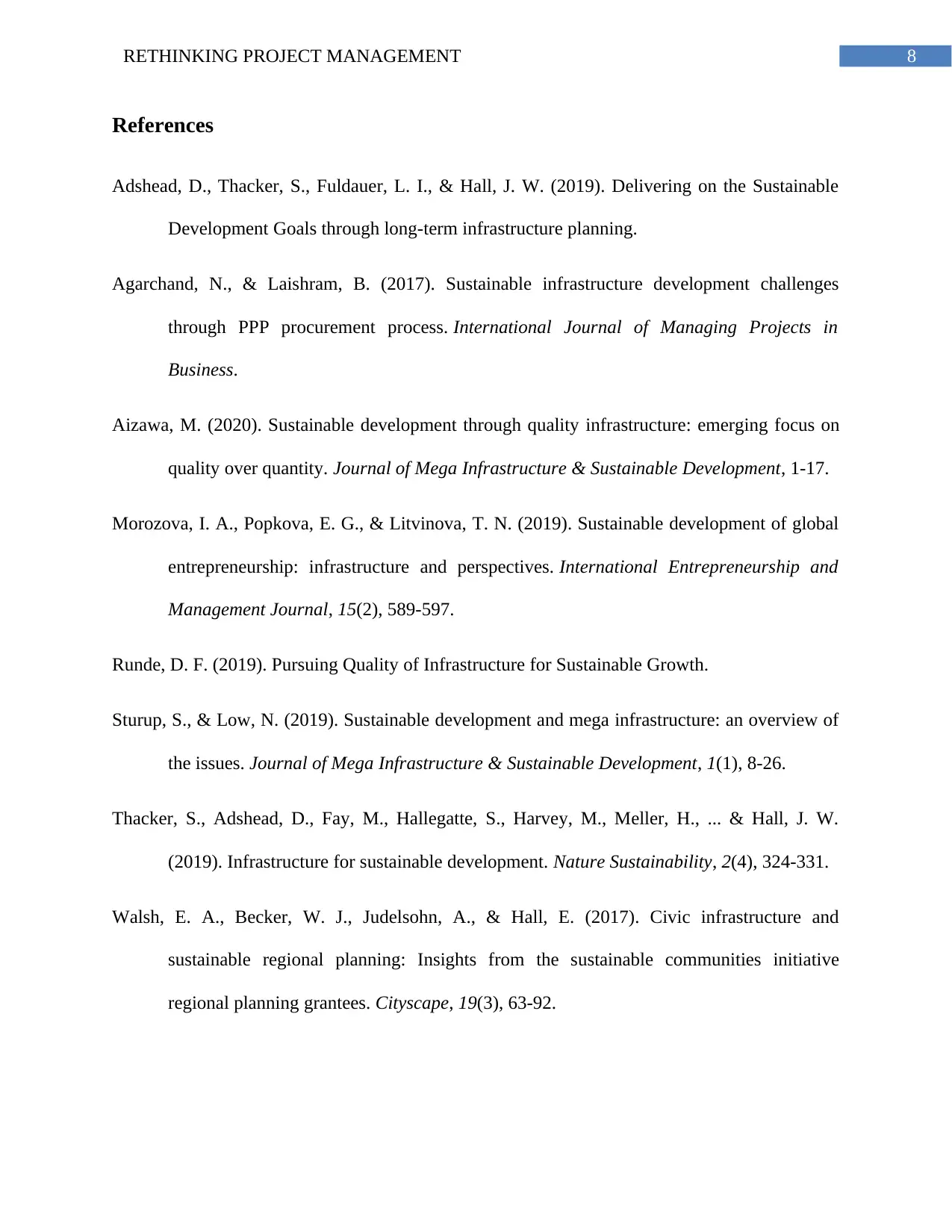
8RETHINKING PROJECT MANAGEMENT
References
Adshead, D., Thacker, S., Fuldauer, L. I., & Hall, J. W. (2019). Delivering on the Sustainable
Development Goals through long-term infrastructure planning.
Agarchand, N., & Laishram, B. (2017). Sustainable infrastructure development challenges
through PPP procurement process. International Journal of Managing Projects in
Business.
Aizawa, M. (2020). Sustainable development through quality infrastructure: emerging focus on
quality over quantity. Journal of Mega Infrastructure & Sustainable Development, 1-17.
Morozova, I. A., Popkova, E. G., & Litvinova, T. N. (2019). Sustainable development of global
entrepreneurship: infrastructure and perspectives. International Entrepreneurship and
Management Journal, 15(2), 589-597.
Runde, D. F. (2019). Pursuing Quality of Infrastructure for Sustainable Growth.
Sturup, S., & Low, N. (2019). Sustainable development and mega infrastructure: an overview of
the issues. Journal of Mega Infrastructure & Sustainable Development, 1(1), 8-26.
Thacker, S., Adshead, D., Fay, M., Hallegatte, S., Harvey, M., Meller, H., ... & Hall, J. W.
(2019). Infrastructure for sustainable development. Nature Sustainability, 2(4), 324-331.
Walsh, E. A., Becker, W. J., Judelsohn, A., & Hall, E. (2017). Civic infrastructure and
sustainable regional planning: Insights from the sustainable communities initiative
regional planning grantees. Cityscape, 19(3), 63-92.
References
Adshead, D., Thacker, S., Fuldauer, L. I., & Hall, J. W. (2019). Delivering on the Sustainable
Development Goals through long-term infrastructure planning.
Agarchand, N., & Laishram, B. (2017). Sustainable infrastructure development challenges
through PPP procurement process. International Journal of Managing Projects in
Business.
Aizawa, M. (2020). Sustainable development through quality infrastructure: emerging focus on
quality over quantity. Journal of Mega Infrastructure & Sustainable Development, 1-17.
Morozova, I. A., Popkova, E. G., & Litvinova, T. N. (2019). Sustainable development of global
entrepreneurship: infrastructure and perspectives. International Entrepreneurship and
Management Journal, 15(2), 589-597.
Runde, D. F. (2019). Pursuing Quality of Infrastructure for Sustainable Growth.
Sturup, S., & Low, N. (2019). Sustainable development and mega infrastructure: an overview of
the issues. Journal of Mega Infrastructure & Sustainable Development, 1(1), 8-26.
Thacker, S., Adshead, D., Fay, M., Hallegatte, S., Harvey, M., Meller, H., ... & Hall, J. W.
(2019). Infrastructure for sustainable development. Nature Sustainability, 2(4), 324-331.
Walsh, E. A., Becker, W. J., Judelsohn, A., & Hall, E. (2017). Civic infrastructure and
sustainable regional planning: Insights from the sustainable communities initiative
regional planning grantees. Cityscape, 19(3), 63-92.
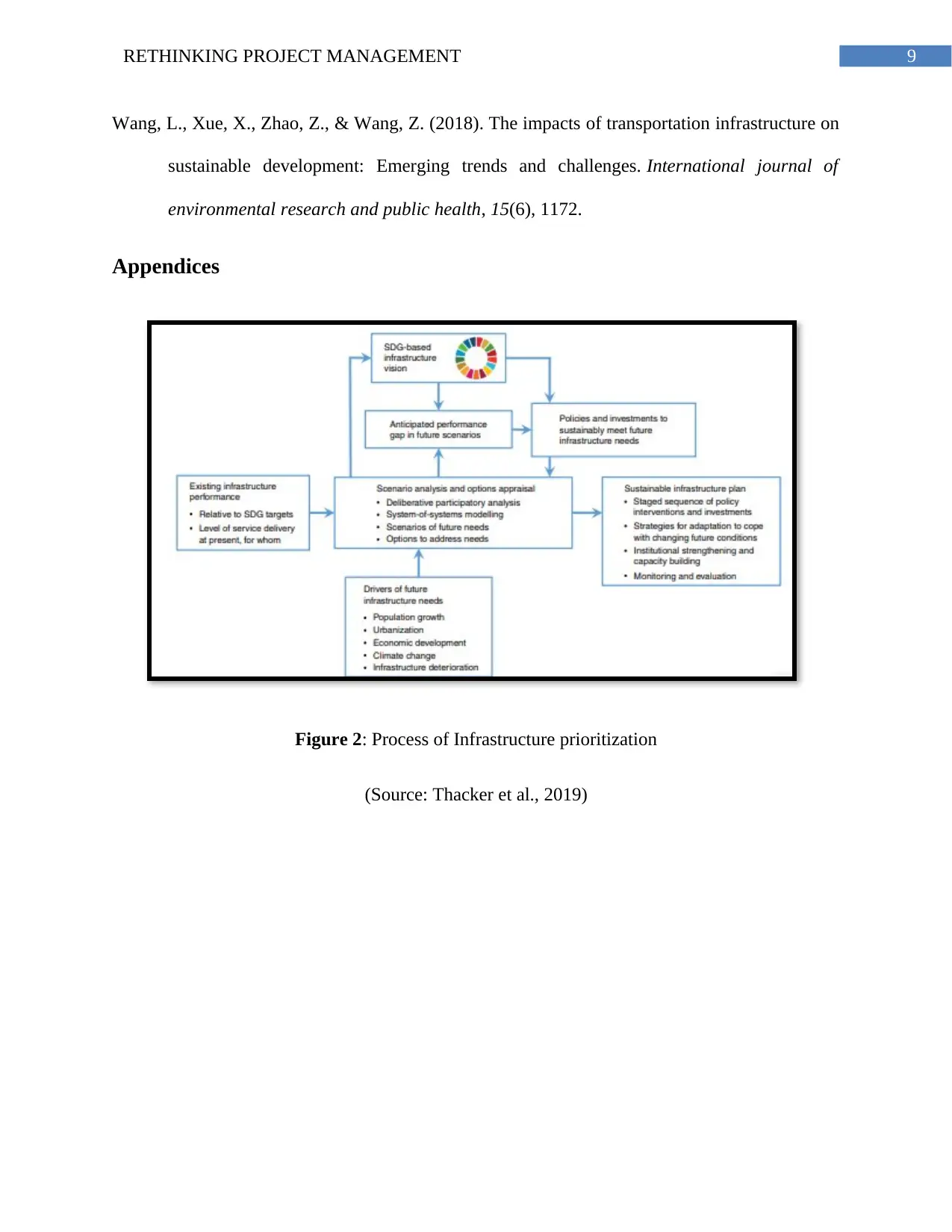
9RETHINKING PROJECT MANAGEMENT
Wang, L., Xue, X., Zhao, Z., & Wang, Z. (2018). The impacts of transportation infrastructure on
sustainable development: Emerging trends and challenges. International journal of
environmental research and public health, 15(6), 1172.
Appendices
Figure 2: Process of Infrastructure prioritization
(Source: Thacker et al., 2019)
Wang, L., Xue, X., Zhao, Z., & Wang, Z. (2018). The impacts of transportation infrastructure on
sustainable development: Emerging trends and challenges. International journal of
environmental research and public health, 15(6), 1172.
Appendices
Figure 2: Process of Infrastructure prioritization
(Source: Thacker et al., 2019)
1 out of 10
Your All-in-One AI-Powered Toolkit for Academic Success.
+13062052269
info@desklib.com
Available 24*7 on WhatsApp / Email
![[object Object]](/_next/static/media/star-bottom.7253800d.svg)
Unlock your academic potential
© 2024 | Zucol Services PVT LTD | All rights reserved.


